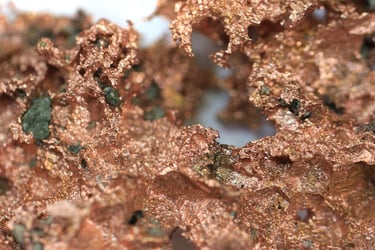When most people think of the metal-making process, they picture a stream of molten metal pouring into a mold -- it makes a nice visual for films and commercials. But when you consider making parts with powder metal, it may be a little harder to picture the process -- or why one would bother with powder metal in the first place.
How metal powder is made is not necessarily simple, and there are only a handful of advanced powder metallurgy companies in North America. Don't worry -- the important concepts of the PM process aren't too difficult to understand with a proper explanation.
Let’s look at the very first powder metallurgy process step -- you’ll quickly see what separates PM from traditional machining.
The Powder Metallurgy Process: What's the Point?
Is there any reason to specify powder metallurgy over traditional machining beyond “that’s how we’ve always done it”? The answer is a definite “yes” -- and for more reasons than just the low cost.
With conventional manufacturing, you melt it, you roll it, you cast, it you machine it. A lot of steps, and a lot of scrap metal at the end.
Using powder metal reduces waste considerably and therefore can be called an environmentally friendly manufacturing process. Sounds like an oxymoron, but it’s really true!
Leftover metal from machining is minimized. There are no metal chips to throw out. When you look closely, it’s apparent that powder metallurgy is truly a “green process.” In fact, a study by Ford Motor Co. a few years ago showed that the PM process is 15% more energy-efficient than traditional machining.
Naturally machining from a solid workpiece is sometimes a requirement. But with many projects, you can avoid secondary machining entirely by using the powder metal process.
What is powder metal? It's the metal “batter” we start with to form the metal “cake” we end with. Best of all, it's part of a sustainable process. To complete the cycle, products made from metal powder can be recycled and made into … new powder.
How Metal Powder Is Made
Your manufacturer’s powder metal supplier follows careful steps to make a product that provides the superior mechanical and/or magnetic properties your component needs.
1. Choose a powder metal material.
Your options are numerous when it comes to metal powders. It's important to first consult with a powder metallurgy supplier to get the mix that supports your most-needed properties.
The options include:
-
Iron
- Copper
- Brass
- Bronze
- Alloy steels
- Aluminum
- Zinc
- Tin
- Cadmium
- Lead
- Copper
- Chromium
- Magnesium
From there, you can select from numerous alloys -- some premixed -- that provided enhanced mechanical or magnetic properties. Iron or other ferrous metals are often popular in powder metallurgy because of their magnetic qualities.
2. Make the metal powder.
There are four main methods of making metal powder. Which method is used depends on an abundance of factors -- particularly the type of metal that needs to be powdered and the properties you’re prioritizing.
The methods for making powder metal include:
- Solid-state reduction
- Atomization
- Electrolysis
- Chemical
- Centrifugal atomization
Solid-State Reduction
The metal ore is crushed and then mixed with another material, usually carbon. Once the mix is complete, it’s put through a furnace to create a reaction that lowers the oxygen and carbon levels in the powder.
The reduction in carbon and oxygen leaves the metal mix resembling a less-delicious sponge cake. The “sponge” is crushed and sifted to remove non-metal material. The final particles are still sponge-like, which is a good thing -- this means they compress well.
Solid-state reduction is an old process but can require up to 3 days in a kiln to fully reduce the iron ore to iron. It requires ore of relatively high purity to get a desirable final product.
Atomization
This process begins with scrap metal that is then melted. Once molten, the stream of metal is poured through jets of gas or water, which causes the metal to disintegrate. The goal is to fragment or atomize the metal into small droplets that solidify before they come into contact with a surface or with one another.
Atomization is quite effective for creating metal powders and can be used on all types of melted metal. It is commonly used to powder:
- Iron
- Bronze
- Alloy steels
- Copper
- Brass
- Aluminum
- Zinc
- Cadmium
- Lead
Electrolysis
The electrolysis process requires specific conditions to be effective, including proper:
- Electrolyte composition and concentration
- Density
- Temperature
As long as the proper conditions can be obtained, electrolysis can create metal powders that are very pure and dense. Electrolysis is expensive relative to other methods for making metal powders. It sees use primarily on high-value metals -- particularly copper for applications where high conductivity is necessary.
Chemical
The three primary methods of chemical powder treatments are:
- Thermal decomposition
- Oxide reduction
- Precipitation from solutions
The processes can produce metal powders with very specific qualities. For example, thermal decomposition is used mostly to process carbonyls, while solution precipitation makes powders that are high in purity and feature narrow particle size distributions.
Centrifugal Atomization
Another way to atomize molten metal involves using a centrifuge, one that includes a perforated container that separates the liquid metal into specific size droplets. The speed of the machine can be changed depending on the desired results.
How Are Powder Metal Parts Made?
Metal powder flows smoothly and can form complex shapes -- strong enough for the toughest components. By given metal certain electromagnetic characteristics, we can make advanced motors and vehicles.
This isn't your father's press-and-sinter technology! With a baseline knowledge of powder metal in your toolkit, now we can show how the “batter” becomes a sintered part “cake." Our next in-depth look at the complex processes of powdered metallurgy takes a look at the manufacturing process itself. Read it here: How Are Powder Metal Parts Made?
Or, if you have more questions about how advanced powder metal materials can improve electric motor efficiency for several industries, try the free e-book and related resources below:
Other Related Resources
- How Does Powder Metal Allow for Net Shape Parts?
- Machining Powder Metal Parts: Rarely Necessary, Usually a Pain
- Powder Metallurgy and Sintering 101: 6 Fascinating Facts
(Editor's note: This article was originally published in April 2019 and was recently updated.)



